
Station Name: HOLLAND ROAD HALT[Source: Nick Catford]
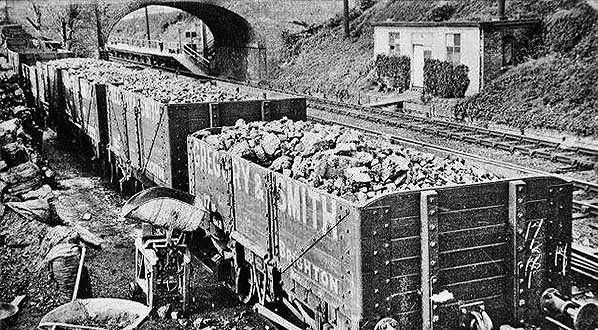 The Holland Road goods yard was to the east of Holland Road Halt, seen here in the background. Behind the photographer was a goods shed while sidings fanned out to his left. The railway had yet to be electrified, this occurring in 1933 so this photograph will date from the 1905 - 1933 period, the former year being when Holland Road Halt opened. Running along the south side of the goods yard, but out of view here, was a siding serving Hove Electricity Works (generating station) for deliveries of coal. The works stood at the corner of Holland Road and Davigdor Road. At least two of the wagons seen here are private owner coal wagons of Messrs. Gregory & Smith, who for many years had offices at 138 Western Road, Brighton. The object at bottom left is coal scales mounted on a barrow-type chassis. Once very common, these scales came in various forms. Some were end discharging, some side discharging, some with a rotating scuttle for either method of discharge. The example seen here is side discharging only. Capacity was usually up to 1cwt and it is possible sacks were positioned for loading and removal by means of the wheelbarrow. Unloading the 12 ton wagon 1cwt at a time would mean 240 scuttle loads occupying an excessive amount of time, so the presence of the scales near the wagon may be pure coincidence and more relevant to the bunker and sacks on the left.
Photo from Jim Lake collection  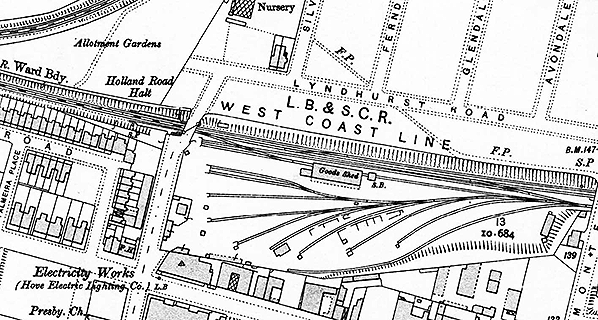
1911 1:2,500 OS map. Holland Road Halt is seen on the west side of Holland Road with Holland Road goods depot on the east side of Holland Road on the site of the original Hove station and goods yard. The Cliftonville Curve is seen top left. A number of new residential roads have been laid out to the north of the line but no housing has yet been built. Click here for a larger version
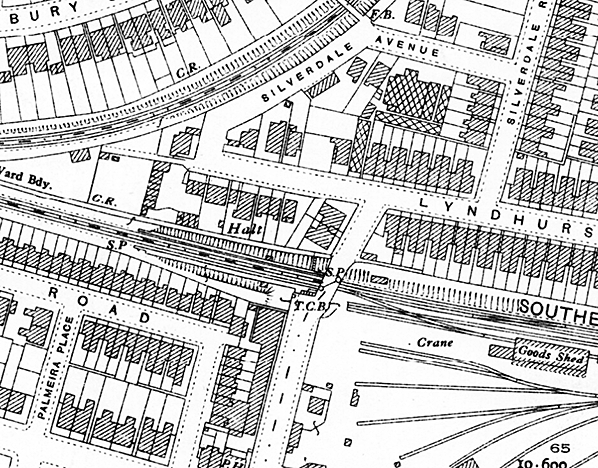
1931 1:2,500 OS map.
 1952 1:2,500 OS map. They layout of the halt is clearly seen with steps to the down platform from the bridge and steps to the up platform running down the embankment at right angles to the platform, joining the platform alongside the ticket office. The two corrugated iron waiting shelters are also seen opposite each other.
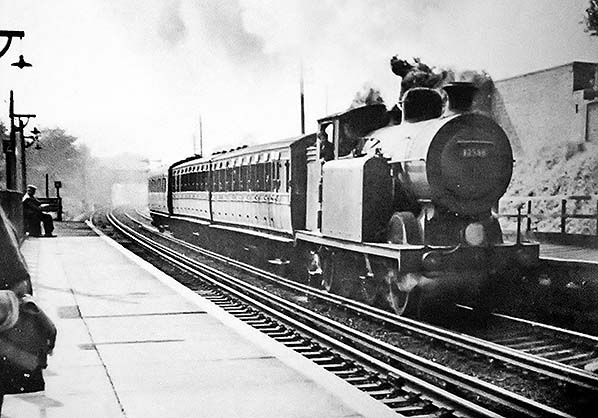
Ex-LB&SCR Billinton 0-6-2T Class E5X No.32586 at Holland Road with a rather odd train which appears to comprise an ex-LB&SCR 2-car Push-Pull set plus what looks like a Maunsell Corridor Third. It may have been an empty stock working, perhaps in connection with Lancing Works and it should be noted that the Southern headcode system generally denoted route rather than train type. The E5 class comprised thirty locomotives of which four were rebuilt with larger boilers, making them rather top heavy and somewhat rough-riding. These four rebuilds became Class E5X and one of them was No.32586, seen here. This locomotive had been built at Brighton in 1903 and was allocated to Brighton shed at the time of withdrawal from service in April 1955, thus we have the latest possible date for this photograph. The sign at the end of the platform appears in several photographs. It is a 'Car Stop' sign telling drivers where to bring their trains to a halt. However, it is not entirely clear if the sign displays '4' or '6'. Most local electric trains along this line appear to have comprised four cars.
Photo from Roger Squires 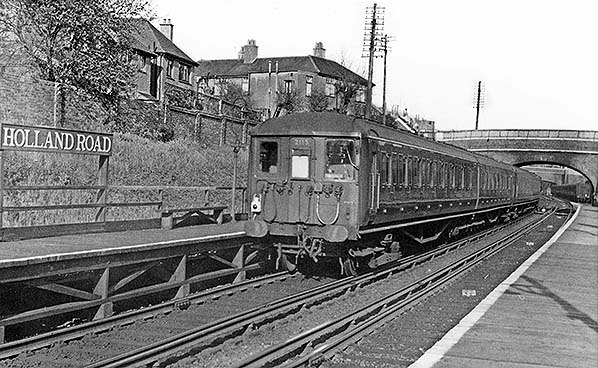 Sometime in British Railways days a four-car EMU with 2-BIL unit No.2115 at the rear departs Holland Road for Brighton. On the platform the distinctive running-in board, which may have dated back to 'Brighton' days can be seen along with a lamp standard bearing a Southern Railway 'target' sign. In the background, between the two bridges and on the south side of the line, was Holland Road goods yard. On this occasion a rake of locomotive-hauled stock is stabled on the loop; one of two, the second of which gave access to the double-ended goods shed out of view to the right of the stabled stock. The designation '2-BIL' meant '2-car Bi Lavatory', in simpler terms a two-car unit with lavatory in each car. Unit 2115 was the penultimate member of the third batch of 2-BILs and, new in December 1937, was originally intended for Portsmouth - Bognor Regis services although such intentions were actually for accountancy rather than operational purposes. The 2-BILs soldiered on long enough to be designated BR Class 401 and many late survivors went on to receive blue livery. The type bowed out of regular service in 1971 but one example has survived into preservation, this being unit No.2090 which, still in its original formation, continued to operate for many years on specials over parts of the Southern Region network along with also-preserved 4-SUB No.4732. Sadly, No.2090 no longer operates and is a static exhibit at the National Railway Museum. Unit No.2115 comprised Motor Brake Third No.10681 and Driving Trailer Composite No.12148 (nearest the camera). Withdrawn on 11 October 1969, No.2115 was then stripped for parts and removed for scrap from Guildford on 17 February 1970. Arrival at the scrapyard of Armytage & Sons Ltd,, Sheepbridge, Chesterfield, occurred nine days later with car No.12148 being broken up on 7 March 1970 and No.10681 seven days later.
Photo by A Vicat 
Holland Road Halt looking north-west from the steps to the down platform circa mid 1950s. A number of Southern Railway target signs are seen on the lamp standards. Lighting at Holland Road was supported by a mix of cast iron and concrete standards, the latter being a product of the one-time concrete works at Exmouth Junction. Those seen on the down platform are concrete while those on the up are cast iron. One of the corrugated iron waiting shelters is seen, a similar shelter stood opposite on the up platform.
Photo from John Mann collection halt_old6.jpg)
On 17 March 1956 an electric multiple unit train arrives at Holland Road, a few weeks before the halt closed, on a Brighton to Worthing service. The train is formed of 2 x 2-car units, the leading unit being recorded as 2-NOL No.1825. The designation 2-NOL stood for '2-car No Lavatory' and the NOLs, as they were known, had an interesting history. Constructed on new underframes, the bodies were modified, lengthened, ex-LSWR steam-hauled stock. Unit No.1825 entered service in April 1935; intended for the Sevenoaks scheme it was from a batch charged to the Eastbourne scheme for accountancy reasons but which entered service on West Worthing - Brighton services. Despite being also seen in the London area, the type thus became mostly associated with South Coast services as seen in this view. During WWII No.1825 was one of a few NOLs modified to have a larger van for the conveyance of goods and one such job was conveying vegetables grown at Broadmoor Hospital from Reading to Waterloo. The NOLs were withdrawn from 1941, due to bomb damage, and due to accident damage at various times but the bulk of the type went during the 1950s. The final examples went in 1959 and No.1825 was among them although it did not last until the very end in August of that year, the final pair being Nos.1826 and 1830. That was not quite the end, however. The wooden bodies were removed and, it is said, burned at Newhaven but many underframes were reused under new units (2-HAP and 2-EPB types plus a few odd vehicles of the 4-EPB fleet) then being built while a few other NOLs soldiered on a while longer in departmental service.
Photo by E Wilmhurst halt_old8.jpg)
The entrance to the up platform at Holland Road Halt in 1956, shortly before the halt was closed. A closure poster is seen on the notice board on the right. From here wooden steps led down to the platform with the small ticket office at the bottom of the steps.
Photo
by JL Smith
halt_old10.jpg)
Looking west towards Shoreham from Holland Road bridge in 1956, shortly before closure of the halt.
Photo by JL Smith halt_old9.jpg)
Looking west from beneath Holland Road bridge in 1956, shortly before the halt was closed. The steps to the down platform (left) led up to an entrance on the bridge. The steps to the up platform ran from the ticket office seen here, and up the embankment at right angles to the platform.
Photo by JL Smith  Ex-LB&SCR Billinton K Class Mogul (2-6-0) BR No.32340 passes Holland Road sometime prior to 1956. Originating in 1913, the K Class were powerful and sprightly machines designed to slot-in with the then expanding electric services in the London area. The class comprised just seventeen examples but three more under construction at the time of The Grouping in 1923 were cancelled by the Southern Railway. How advanced construction was and what became of the partially built locomotives remains something of a mystery. Otherwise the class was destined to become noteworthy through surviving intact, with not a single loss, until withdrawn by British Railways during November and December 1962 with No.32340, new in June 1914, going on 23 December. The class was stored at Hove for quite some time, being still in good condition, with one example being reinstated to assist during the severe winter of 1962/3 but this reinstatement is not well recorded and the identity of the locomotive involved is unclear. The then fledgling Bluebell Railway had hoped to preserve an example of the K Class but for funding reasons were unsuccessful. Only one example survives today, in a manner of speaking, this being a one-sixth scale working model constructed by Billinton himself. One may wonder why a steam-hauled passenger train was running over the electrified tracks through Holland Road carrying the Eastbourne - Brighton route disc headcode. The train is fitted with roof destination boards and the third vehicle is a catering vehicle of some description. The train, or perhaps by its short length a portion of one, will have been one of the through services originating outside the Southern Region of which there were, for example, services to Brighton from Cardiff and Plymouth. The Southern disc/lamp headcode system was unique and thus that applied to No.32340 would have been applicable from the point at which the locomotive took over the train. Most of the carriages are in the early BR livery and the locomotive tender carries the early BR emblem known as the 'Cycling Lion' or, more mockingly, the 'Emaciated Ferret'. One might assume the carriage livery is carmine and cream but, depending upon the train's origin, may have been Western Region brown and cream. The livery of the catering vehicle is open to question for, if BR maroon, the photograph would be no earlier than 1956 - the year Holland Road Halt closed.
Photo from John Mann collection halt_old2.jpg) Looking east along the down platform at Holland Road Halt possibly after closure of the halt on 7 May 1956. All the platform signage appears to have been removed. This picture clearly illustrates access to both platforms. Access to the down platform is by steps up to an entrance on the bridge. Access to the up platform is alongside the ticket office, probably passing a ticket window. The steps run up the embankment at right angles to the platform with the entrance a few yards along the top of the cutting from the bridge. A loop that gave access to the Holland Road goods depot is seen on the far side of the bridge on the down side. The goods depot closed 14 June 1971. Looking east along the down platform at Holland Road Halt possibly after closure of the halt on 7 May 1956. All the platform signage appears to have been removed. This picture clearly illustrates access to both platforms. Access to the down platform is by steps up to an entrance on the bridge. Access to the up platform is alongside the ticket office, probably passing a ticket window. The steps run up the embankment at right angles to the platform with the entrance a few yards along the top of the cutting from the bridge. A loop that gave access to the Holland Road goods depot is seen on the far side of the bridge on the down side. The goods depot closed 14 June 1971.Photo
from John Mann collection
halt1.jpg) The site of Holland Road Halt up platform in July 1962. The concrete blocks supported the steps down to the platform. The site of Holland Road Halt up platform in July 1962. The concrete blocks supported the steps down to the platform.Photo by Ian Noble from his Flickr photostream halt2.jpg)
The site of Holland Road Halt looking west in September 2006.
Photo by Simon Carey, reproduced from Geograph under creative commons licence
|
 Notes: The lines now operated under the banner 'West Coastway' have a complex history and were built in stages by five different companies between 1840 and 1889. The line from Brighton to Shoreham was a branch of the London and Brighton Railway which opened 12 May 1840, before the completion of the main line. The extensions of this line to Worthing (opened 24 November 1845), to Arundel & Littlehampton (opened 16 March 1846) and to Chichester (opened 8 June 1846) were built by the Brighton and Chichester Railway. In July 1846 these two companies merged with others to form the London, Brighton and South Coast Railway (LBSCR), which continued the line to Havant (opened 15 March 1847) and Portsmouth (opened 14 June 1847). Part of this section became jointly owned with the London and South Western Railway (LSWR), following the opening of the LSWR line from Fareham to Portcreek Junction on 1 October 1848 (connecting to the Eastleigh–Fareham line).
Notes: The lines now operated under the banner 'West Coastway' have a complex history and were built in stages by five different companies between 1840 and 1889. The line from Brighton to Shoreham was a branch of the London and Brighton Railway which opened 12 May 1840, before the completion of the main line. The extensions of this line to Worthing (opened 24 November 1845), to Arundel & Littlehampton (opened 16 March 1846) and to Chichester (opened 8 June 1846) were built by the Brighton and Chichester Railway. In July 1846 these two companies merged with others to form the London, Brighton and South Coast Railway (LBSCR), which continued the line to Havant (opened 15 March 1847) and Portsmouth (opened 14 June 1847). Part of this section became jointly owned with the London and South Western Railway (LSWR), following the opening of the LSWR line from Fareham to Portcreek Junction on 1 October 1848 (connecting to the Eastleigh–Fareham line).
 The original Hove railway station on the Brighton to Shoreham line opened on with the line 11 May 1840. It closed on 1 March 1880 following the opening of the Cliftonville Curve which opened in July 1879 and linked the Shoreham line to the Brighton Main Line between Hove and Preston Park. After closure Hove station was rebuilt as the Holland Road Goods depot. The existing Hove station opened on 1 October 1865 as Cliftonville; it was later named West Brighton, before being renamed Hove and West Brighton in 1894 and finally Hove in 1895.
The original Hove railway station on the Brighton to Shoreham line opened on with the line 11 May 1840. It closed on 1 March 1880 following the opening of the Cliftonville Curve which opened in July 1879 and linked the Shoreham line to the Brighton Main Line between Hove and Preston Park. After closure Hove station was rebuilt as the Holland Road Goods depot. The existing Hove station opened on 1 October 1865 as Cliftonville; it was later named West Brighton, before being renamed Hove and West Brighton in 1894 and finally Hove in 1895.
 The halt was built with timber platforms, which it retained until its closure, and also had wooden steps from the overbridge to the platforms. Each platform was provided with a small corrugated iron waiting shelter and there was a small timber ticket office at the bottom of the stairs on the up side. In February 1956, British Railways proposed closing the halt because passenger numbers were low, the halt was closed from Monday 7 May 1956 the last train running the previous day (Sunday). By this time, only the all-stations trains to West Worthing and a small number of peak-hour services to and from Horsham via Shoreham-by-Sea called there. The timber platforms were demolished shortly after closure and by 1962 there was little evidence of the stations other that concrete blocks that supported the wooden steps on the up side. Holland Road goods depot closed on 14 June 1971; the site is now the Peacock Industrial Estate.
The halt was built with timber platforms, which it retained until its closure, and also had wooden steps from the overbridge to the platforms. Each platform was provided with a small corrugated iron waiting shelter and there was a small timber ticket office at the bottom of the stairs on the up side. In February 1956, British Railways proposed closing the halt because passenger numbers were low, the halt was closed from Monday 7 May 1956 the last train running the previous day (Sunday). By this time, only the all-stations trains to West Worthing and a small number of peak-hour services to and from Horsham via Shoreham-by-Sea called there. The timber platforms were demolished shortly after closure and by 1962 there was little evidence of the stations other that concrete blocks that supported the wooden steps on the up side. Holland Road goods depot closed on 14 June 1971; the site is now the Peacock Industrial Estate.


 Home Page
Home Page